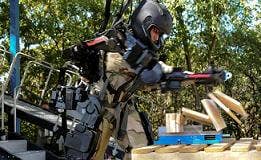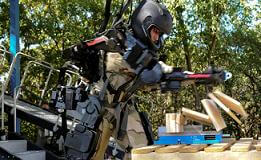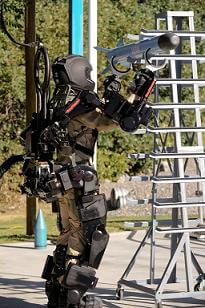Raytheon’s New XOS 2 Exoskeleton Looks Cool, but It’s Not Iron Man (video)

Share
Blame it on Tony Stark's ego, but Raytheon's debut of the XOS 2 Exoskeleton focuses too much on the Iron Man theme. Raytheon (via Sarcos) developed the XOS 2 for the army to help carry and move loads. It's great at this job. The suit uses hydraulic power to grant its operator super human endurance while moving heavy weights. It can delicately load explosive ordinance, or punch through wood with equal ease. Raytheon's 'Iron-Man' dreams, however, are burdened by one tremendous anchor - the exoskeleton operates on a tether. That's right, all that power means the XOS 2 has to remain wired to run. Its developers don't think it will get off the tether for at least eight years. That hasn't stopped Raytheon from hyping the XOS as a big step towards a real world Iron Man suit, they even recruited actor Clark Gregg (who portrays a SHIELD agent in the movies) to come out and play with the exoskeleton. It's too bad that Raytheon is over-hyping the XOS 2, because, as you can see in the videos below, it looks pretty amazing for what it is: a humanoid forklift.
Raytheon deserves some praise for what it's accomplished with its XOS 2 exoskeleton. This new suit looks a little less clunky, and a lot more refined, than the XOS 1 we reviewed earlier. It also only uses 50% of the power of its predecessor. The goal is to get that down to 20%. Efficiency is always good. Raytheon also claims that the XOS 2 can handle weather and environmental stresses better. Watching the XOS 2 in action I can easily see it in an army base. A single soldier could quickly load or unload materials and free up valuable time for others to perform missions.
Even with reductions in power consumption, however, the XOS 2's tether really restricts its applications. It's only going to be found in bases, helping support personnel perform tasks more efficiently. I think it's telling in the video when Raytheon VP (Fraser Smith) discusses the 'combat version' as only containing the elements of the XOS 2 from the waist down (~1:48). It sounds almost identical to Lockheed Martin's HULC exoskeleton project which is also under development for the army. No matter who makes it, I have a hard time believing that an exo designed for weight lifting will see combat in the near future. These systems simply wouldn't be reliable enough to risk people's lives using them in dangerous situations.
Which is fine, because the tethered humanoid forklift application should really be enough to satisfy us for now. Modern armies rely heavily upon logistics officers and workers who keep bases and equipment well supplied. The easier those jobs can be done, the farther and faster a military can extend its reach.
Be Part of the Future
Sign up to receive top stories about groundbreaking technologies and visionary thinkers from SingularityHub.


Yet these robotic suits are likely to face their greatest uses outside of warfare. Commercial exoskeletons could let humans work faster and longer in industrial applications. Or, they could become a valuable tool for medical professionals who need to move and assist patients. We have an aging population that will need people to help them get up, go to the bathroom, and change clothes. Not as glorious as dreams about becoming Iron Man, but infinitely more practical.
In the end, robots may become advanced enough that exoskeletons are unneeded. Modern warehouses are finding ways to keep humans from heavy lifting, and we've seen elder-care bots that can do the same for nursing homes. It may be the only real use that exoskeletons serve in the future is as expensive and fun playthings.
...I'm pretty cool with that, actually. I may complain about Raytheon's love for hype, but I would love to own an Iron Man suit of my own. Look, to show there's no hard feelings, here's the even more 'Marvel-ous' version of the XOS 2 video, with enough explosions and action to please Tony Stark himself. Enjoy:
[image and video credits: Raytheon]
[source: Raytheon]
Related Articles

These Robots Are the Size of Single Cells and Cost Just a Penny Apiece

In Wild Experiment, Surgeon Uses Robot to Remove Blood Clot in Brain 4,000 Miles Away

A Squishy New Robotic ‘Eye’ Automatically Focuses Like Our Own
What we’re reading

